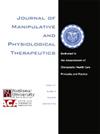虚拟现实对慢性颈痛患者姿势控制的影响:一项单盲随机对照研究。
IF 1.4
4区 医学
Q4 HEALTH CARE SCIENCES & SERVICES
Journal of Manipulative and Physiological Therapeutics
Pub Date : 2023-05-01
DOI:10.1016/j.jmpt.2024.02.006
引用次数: 0
摘要
研究目的本研究旨在探讨虚拟现实(VR)对慢性颈痛(CNP)患者的姿势控制、姿势和运动恐惧症的影响:方法:41 名 CNP 患者被随机分配到 VR 组和对照组。VR 组佩戴眼镜体验 VR 20 分钟,然后进行运动控制(MC)练习 20 分钟。对照组只进行 40 分钟的运动控制练习。两组均在 6 周内接受了 18 次训练。记录了计算机动态体位测量的结果,包括感觉组织测试(SOT)、稳定性极限和单侧站立测试、步速、前头姿势(FHP)、肩前伸(SP)、颈椎前凸角度、运动恐惧症和锻炼依从性:VR 组对 SOT 的综合平衡(Cohen's d = 1.20)和运动恐惧(Cohen's d = -0.96)的影响更大(P < .05)。此外,VR 组在锻炼依从性方面更为有效(P < .05)。与这些结果相反,对照组在纠正 FHP 和 SP 方面更为有效(Cohen's d > 0.7,P < .05):结论:虚拟现实似乎对慢性颈痛患者的姿势控制、姿势和运动恐惧有一定的影响。本文章由计算机程序翻译,如有差异,请以英文原文为准。
Effects of Virtual Reality for Postural Control in Chronic Neck Pain: A Single-Blind, Randomized Controlled Study
Objective
The purpose of this study was to investigate the effects of virtual reality (VR) on postural control, posture, and kinesiophobia in patients with chronic neck pain (CNP).
Methods
Forty-one participants with CNP were randomly allocated to the VR and control groups. The VR group experienced VR with glasses for 20 minutes and then performed motor control (MC) exercises for 20 minutes. The control group received only MC exercises for 40 minutes. Both groups received 18 sessions over 6 weeks. Computerized dynamic posturography outcomes, including sensory organization test (SOT), limits of stability, and unilateral stance tests, gait speed, forward head posture (FHP), shoulder protraction (SP), cervical lordosis angle, kinesiophobia, and exercise compliance were recorded.
Results
The VR group had more effects regarding composite equilibrium (Cohen's d = 1.20) of SOT and kinesiophobia (Cohen's d = −0.96), P < .05). Also, the VR group was more effective in exercise compliance (P < .05). Contrary to these results, the control group was more effective in correcting FHP and SP (Cohen's d > 0.7, P < .05).
Conclusion
Virtual reality seemed to have an effect on postural control, posture, and kinesiophobia in patients with chronic neck pain.
求助全文
通过发布文献求助,成功后即可免费获取论文全文。
去求助
来源期刊
CiteScore
3.00
自引率
7.70%
发文量
63
审稿时长
29 weeks
期刊介绍:
The Journal of Manipulative and Physiological Therapeutics (JMPT) is an international and interdisciplinary journal dedicated to the advancement of conservative health care principles and practices. The JMPT is the premier biomedical publication in the chiropractic profession and publishes peer reviewed, research articles and the Journal''s editorial board includes leading researchers from around the world.
The Journal publishes original primary research and review articles of the highest quality in relevant topic areas. The JMPT addresses practitioners and researchers needs by adding to their clinical and basic science knowledge and by informing them about relevant issues that influence health care practices.

 求助内容:
求助内容: 应助结果提醒方式:
应助结果提醒方式:


